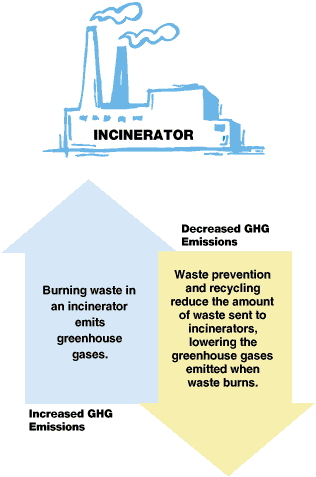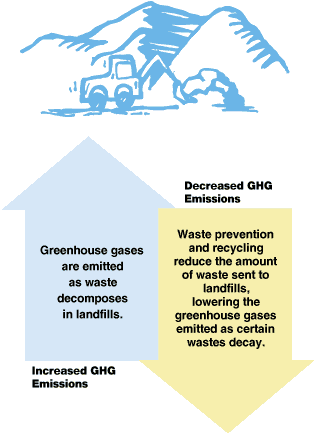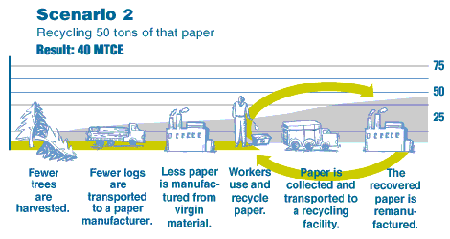Climate Change and Municipal Solid Waste (MSW)
More Fact Sheets
- General Public
- MSW Planners
- State Officials
- Elected Officials
- Civic Groups
- PAYT & Climate Change
- Climate Change & MSW
What is the Greenhouse Effect? | What Are the Consequences of Climate Change? | What Is the Link Between Solid Waste and Climate Change? | What are Greenhouse Gases? | The Balance Sheet: Measuring Climate Change Benefits of Waste Reduction | The Link Between Waste Management and Greenhouse Gases | You Can Make a Difference! | How Are EPA's Waste Reduction Programs Helping Reduce the Effects of Climate Change? | More Information
Two Environmental Issues With an Important Underlying Link
Rising levels of greenhouse gases in the Earth's atmosphere are causing changes in our climate, and some of these changes can be traced to solid waste. The manufacture, distribution, and use of products-as well as management of the resulting waste-all result in greenhouse gas emissions. Waste prevention and recycling are real ways to help mitigate climate change.This site describes the connection between climate change and solid waste, explains how waste reduction can help slow the effects of climate change, and outlines the U.S. Environmental Protection Agency's (EPA's) efforts to address this important issue.
What is the Greenhouse Effect?
The atmosphere that surrounds the Earth contains many types of gases, including those known as "greenhouse gases." Greenhouse gases absorb and retain heat from the sun. They regulate the Earth's climate by holding warmth in an atmospheric blanket around the planet's surface. Scientists call this phenomenon the "greenhouse effect."
Without greenhouse gases, the average temperature on Earth would be 5°F instead of the current 60°F. Excess greenhouse gases in the atmosphere, however, raise global temperatures.
What Are the Consequences of Climate Change?
What's so bad about warm days and balmy nights? Why try to reduce greenhouse gas emissions? Unfortunately, increased concentrations of greenhouse gases in the atmosphere will not create a worldwide tropical paradise. The Earth's atmosphere supports a balanced variety of climates on which diverse ecosystems depend. Human activities that thicken the gaseous "greenhouse" around the planet threaten to disrupt that balance.
In the last 100 years, scientists have detected an increase of 1°F in the Earth's average surface temperature. There is international scientific consensus that human activity is responsible for some of this increase. A rise of only a few degrees in the Earth's average temperature could result in:
- Wider fluctuations in temperatures
- More frequent and intense storms
- Flooding of beach, marsh, and other low-lying coastal areas
- More precipitation in some areas and not enough in others
- Wider distribution of certain diseases
It is clear, however, that any climate change will not be easily reversed. Because greenhouse gases remain in the atmosphere a long time, turning back climate changes may take decades or even centuries.
What Is the Link Between Solid Waste and Climate Change?
Waste prevention and recycling-jointly referred to as waste reduction-help us better manage the solid waste we generate. But preventing waste and recycling also are potent strategies for reducing greenhouse gases. Together they:
- Reduce emissions from energy consumption. Recycling saves energy. That's because making goods from recycled materials typically requires less energy than making goods from virgin materials. And waste prevention is even more effective. Less energy is needed to extract, transport, and process raw materials and to manufacture products when people reuse things or when products are made with less material. The payoff? When energy demand decreases, fewer fossil fuels are burned and less carbon dioxide is emitted to the atmosphere.
- Reduce emissions from incinerators. Diverting certain materials from incinerators through waste prevention and recycling reduces greenhouse gas emissions to the atmosphere.
- Reduce methane emissions from landfills. Waste prevention and recycling (including composting) divert organic wastes from landfills, reducing the methane released when these materials decompose.
- Increase storage of carbon in trees. Forests take large amounts of carbon dioxide out of the atmosphere and store it in wood, in a process called carbon sequestration. Waste prevention and recycling of paper products can leave more trees standing in the forest, continuing to absorb carbon dioxide from the atmosphere.
The Link Between Waste Management and Greenhouse Gases




You Can Make a Difference!
By choosing to prevent waste and recycle, you can help curb climate change. For example, assume your office throws away 100 tons of white (office) paper each year. If you recycle just half that paper instead, look what happens:
The Balance Sheet: Measuring Climate Change Benefits of Waste Reduction
To help measure the climate benefits of waste reduction initiatives launched by EPA and others, EPA conducted a comprehensive study of greenhouse gas emissions and waste management. The study estimates the greenhouse gas emissions associated with managing ten types of waste materials: office paper, newspaper, corrugated cardboard, aluminum, steel, plastic (HDPE, LDPE, and PET), food scraps, and yard trimmings. The waste management options analyzed are waste prevention, recycling, composting, incineration, and landfilling.
This research indicates that, in terms of climate benefits, waste prevention is the best management option. Recycling is the next best approach to reducing greenhouse gas emissions. Also, the research enables users to tailor their analysis of greenhouse gas emissions based on the characteristics of their waste stream and the waste management options available to them.
EPA estimates that increasing our national recycling rate from its current level of 27 percent to 35 percent would reduce greenhouse gas emissions by 11.4 million metric tons of carbon equivalent (MTCE, the basic unit of measure for greenhouse gases) over landfilling the same material. Waste prevention also makes an important difference: by cutting the amount of waste we generate by just 5 percent, we could reduce greenhouse gas emissions by another 10.2 million MTCE. Together, these levels of recycling and waste prevention slash emissions by more than 20 million MTCE-an amount equal to the average annual emissions from the electricity consumption of roughly 12 million households.
Every little bit helps! For example, if for one year people in an office building of 2,000 workers recycled all the office paper, cardboard, newspaper, and plastic waste they generated, greenhouse gas emissions could fall by 440 MTCE, equivalent to taking about 330 cars off the road that year. If just one household generated 5 percent less waste newspapers, aluminum and steel cans, and plastic containers and then recycled what remains, 374 pounds of carbon equivalent could be reduced.
How Are EPA's Waste Reduction Programs Helping Reduce the Effects of Climate Change?
The United States is committed to reducing greenhouse gas emissions. In 1992, the United States joined 160 other countries as a signatory to the United Nations Framework Convention on Climate Change, which calls on countries to reduce their greenhouse gas emissions. Since 1994, the United States has been implementing the Climate Change Action Plan (CCAP), a blueprint for achieving voluntary reductions in greenhouse gas emissions from all sectors of our economy. The CCAP contains some 50 separate initiatives, including one that aims to reduce greenhouse gas emissions through waste reduction and recycling.
In December 1997, the Parties to the UN Framework Convention on Climate Change agreed to a historic Protocol on climate change. The so-called "Kyoto Protocol" sets binding emissions targets and timetables for emissions reductions, encouraging the use of market-based measures to meet those targets. The specific limits vary from country to country, but are similar for Europe, Japan and the United States; for the United States, the target is to reduce greenhouse gas emissions to a level 7% below 1990 emissions over a 5-year period spanning 2008 to 2012. United States ratification of this Protocol will require the advice and consent of the U.S. Senate.
Waste prevention and recycling can make a significant contribution to reducing greenhouse gas emissions in the United States. The waste reduction and recycling initiative is expected to contribute at least 5 percent of the total greenhouse gas emission reductions called for in the CCAP. To help achieve these kinds of greenhouse gas reductions using waste prevention and recycling, EPA is supporting a number of programs, including:
- WasteWi$e. WasteWi$e is a voluntary partnership between EPA and U.S. businesses, state and local governments, and institutions to prevent waste, recycle, and buy and manufacture products made with recycled materials. More than 700 organizations participated in the WasteWi$e program in 1997.
- Pay-As-You-Throw Programs. EPA is providing technical and outreach assistance to encourage communities to implement pay-as-you-throw systems for solid waste. Under pay-as-you-throw, residents are charged based on the amount of trash they discard. This creates an incentive for them to generate less trash and recycle more. On average, communities with pay-as-you-throw see waste reductions of 15 to 28 percent.
- EPA/CBOT Partnership. The Chicago Board of Trade (CBOT) Recyclables Exchange is an online exchange, developed with EPA support, that helps develop markets for recyclable commodities, thereby diverting more materials from the waste stream.
- Waste Reduction Demonstrations. EPA has funded over 20 projects that demonstrate innovative waste reduction approaches with potential to achieve significant carbon emissions reductions.
For More Information
- Climate Change and Waste: Reducing Waste Can Make a Difference - This folder and its series of fact sheets address the links between climate change and municipal solid waste management.
- Go to EPA's Global Climate Change & Solid Waste Web Site
![[logo] US EPA](../gif/logo_epaseal.gif)

